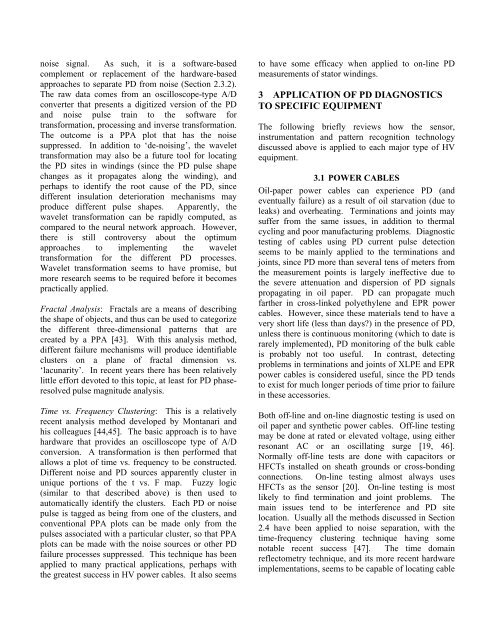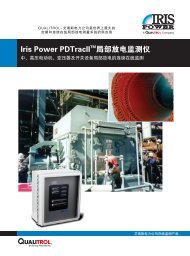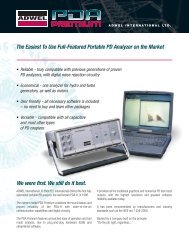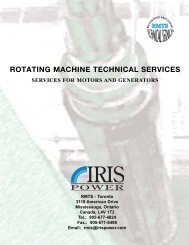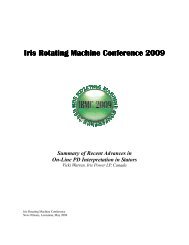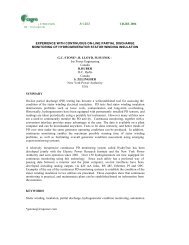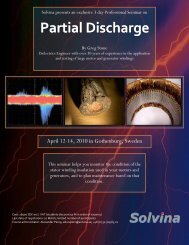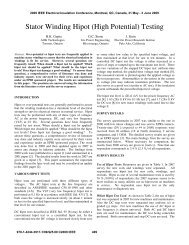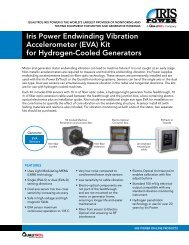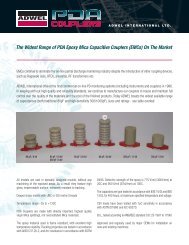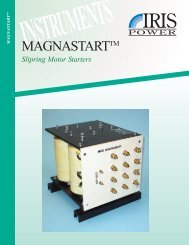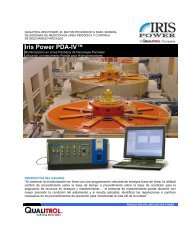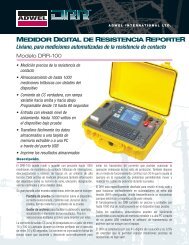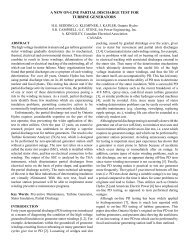Partial Discharge Diagnostics and Electrical Equipment Insulation ...
Partial Discharge Diagnostics and Electrical Equipment Insulation ...
Partial Discharge Diagnostics and Electrical Equipment Insulation ...
Create successful ePaper yourself
Turn your PDF publications into a flip-book with our unique Google optimized e-Paper software.
noise signal. As such, it is a software-basedcomplement or replacement of the hardware-basedapproaches to separate PD from noise (Section 2.3.2).The raw data comes from an oscilloscope-type A/Dconverter that presents a digitized version of the PD<strong>and</strong> noise pulse train to the software fortransformation, processing <strong>and</strong> inverse transformation.The outcome is a PPA plot that has the noisesuppressed. In addition to ‘de-noising’, the wavelettransformation may also be a future tool for locatingthe PD sites in windings (since the PD pulse shapechanges as it propagates along the winding), <strong>and</strong>perhaps to identify the root cause of the PD, sincedifferent insulation deterioration mechanisms mayproduce different pulse shapes. Apparently, thewavelet transformation can be rapidly computed, ascompared to the neural network approach. However,there is still controversy about the optimumapproaches to implementing the wavelettransformation for the different PD processes.Wavelet transformation seems to have promise, butmore research seems to be required before it becomespractically applied.Fractal Analysis: Fractals are a means of describingthe shape of objects, <strong>and</strong> thus can be used to categorizethe different three-dimensional patterns that arecreated by a PPA [43]. With this analysis method,different failure mechanisms will produce identifiableclusters on a plane of fractal dimension vs.‘lacunarity’. In recent years there has been relativelylittle effort devoted to this topic, at least for PD phaseresolvedpulse magnitude analysis.Time vs. Frequency Clustering: This is a relativelyrecent analysis method developed by Montanari <strong>and</strong>his colleagues [44,45]. The basic approach is to havehardware that provides an oscilloscope type of A/Dconversion. A transformation is then performed thatallows a plot of time vs. frequency to be constructed.Different noise <strong>and</strong> PD sources apparently cluster inunique portions of the t vs. F map. Fuzzy logic(similar to that described above) is then used toautomatically identify the clusters. Each PD or noisepulse is tagged as being from one of the clusters, <strong>and</strong>conventional PPA plots can be made only from thepulses associated with a particular cluster, so that PPAplots can be made with the noise sources or other PDfailure processes suppressed. This technique has beenapplied to many practical applications, perhaps withthe greatest success in HV power cables. It also seemsto have some efficacy when applied to on-line PDmeasurements of stator windings.3 APPLICATION OF PD DIAGNOSTICSTO SPECIFIC EQUIPMENTThe following briefly reviews how the sensor,instrumentation <strong>and</strong> pattern recognition technologydiscussed above is applied to each major type of HVequipment.3.1 POWER CABLESOil-paper power cables can experience PD (<strong>and</strong>eventually failure) as a result of oil starvation (due toleaks) <strong>and</strong> overheating. Terminations <strong>and</strong> joints maysuffer from the same issues, in addition to thermalcycling <strong>and</strong> poor manufacturing problems. Diagnostictesting of cables using PD current pulse detectionseems to be mainly applied to the terminations <strong>and</strong>joints, since PD more than several tens of meters fromthe measurement points is largely ineffective due tothe severe attenuation <strong>and</strong> dispersion of PD signalspropagating in oil paper. PD can propagate muchfarther in cross-linked polyethylene <strong>and</strong> EPR powercables. However, since these materials tend to have avery short life (less than days?) in the presence of PD,unless there is continuous monitoring (which to date israrely implemented), PD monitoring of the bulk cableis probably not too useful. In contrast, detectingproblems in terminations <strong>and</strong> joints of XLPE <strong>and</strong> EPRpower cables is considered useful, since the PD tendsto exist for much longer periods of time prior to failurein these accessories.Both off-line <strong>and</strong> on-line diagnostic testing is used onoil paper <strong>and</strong> synthetic power cables. Off-line testingmay be done at rated or elevated voltage, using eitherresonant AC or an oscillating surge [19, 46].Normally off-line tests are done with capacitors orHFCTs installed on sheath grounds or cross-bondingconnections. On-line testing almost always usesHFCTs as the sensor [20]. On-line testing is mostlikely to find termination <strong>and</strong> joint problems. Themain issues tend to be interference <strong>and</strong> PD sitelocation. Usually all the methods discussed in Section2.4 have been applied to noise separation, with thetime-frequency clustering technique having somenotable recent success [47]. The time domainreflectometry technique, <strong>and</strong> its more recent hardwareimplementations, seems to be capable of locating cable


